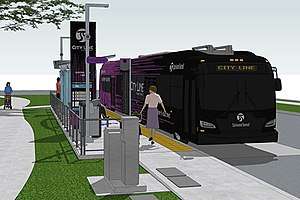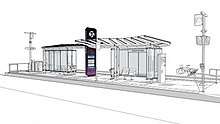City Line (Spokane, Washington)
The City Line is a bus rapid transit (BRT) line in Spokane, Washington, United States, that is currently under construction with service expected to begin in 2022.[3] The 6-mile-long (9.7 km) route, which will be operated by the Spokane Transit Authority, will run from Spokane's Browne's Addition neighborhood, through Downtown Spokane and the University District, including the WSU Health Sciences campus and Gonzaga University, before ending at the Spokane Community College campus.
| City Line | |||||||||||||||||||||||||||||||||||||||||||||||||||||||||||||||||||||||||||||||||||||||||||||||||||||||||||||||||||||||||||||||||||||||||||||||||||||||||||||||||||||||||||||||||||||||||||||||
|---|---|---|---|---|---|---|---|---|---|---|---|---|---|---|---|---|---|---|---|---|---|---|---|---|---|---|---|---|---|---|---|---|---|---|---|---|---|---|---|---|---|---|---|---|---|---|---|---|---|---|---|---|---|---|---|---|---|---|---|---|---|---|---|---|---|---|---|---|---|---|---|---|---|---|---|---|---|---|---|---|---|---|---|---|---|---|---|---|---|---|---|---|---|---|---|---|---|---|---|---|---|---|---|---|---|---|---|---|---|---|---|---|---|---|---|---|---|---|---|---|---|---|---|---|---|---|---|---|---|---|---|---|---|---|---|---|---|---|---|---|---|---|---|---|---|---|---|---|---|---|---|---|---|---|---|---|---|---|---|---|---|---|---|---|---|---|---|---|---|---|---|---|---|---|---|---|---|---|---|---|---|---|---|---|---|---|---|---|---|---|---|
 | |||||||||||||||||||||||||||||||||||||||||||||||||||||||||||||||||||||||||||||||||||||||||||||||||||||||||||||||||||||||||||||||||||||||||||||||||||||||||||||||||||||||||||||||||||||||||||||||
| Overview | |||||||||||||||||||||||||||||||||||||||||||||||||||||||||||||||||||||||||||||||||||||||||||||||||||||||||||||||||||||||||||||||||||||||||||||||||||||||||||||||||||||||||||||||||||||||||||||||
| System | Spokane Transit Authority | ||||||||||||||||||||||||||||||||||||||||||||||||||||||||||||||||||||||||||||||||||||||||||||||||||||||||||||||||||||||||||||||||||||||||||||||||||||||||||||||||||||||||||||||||||||||||||||||
| Operator | Spokane Transit Authority | ||||||||||||||||||||||||||||||||||||||||||||||||||||||||||||||||||||||||||||||||||||||||||||||||||||||||||||||||||||||||||||||||||||||||||||||||||||||||||||||||||||||||||||||||||||||||||||||
| Vehicle | New Flyer battery electric articulated buses | ||||||||||||||||||||||||||||||||||||||||||||||||||||||||||||||||||||||||||||||||||||||||||||||||||||||||||||||||||||||||||||||||||||||||||||||||||||||||||||||||||||||||||||||||||||||||||||||
| Status | Under construction | ||||||||||||||||||||||||||||||||||||||||||||||||||||||||||||||||||||||||||||||||||||||||||||||||||||||||||||||||||||||||||||||||||||||||||||||||||||||||||||||||||||||||||||||||||||||||||||||
| Began service | 2022 (planned) | ||||||||||||||||||||||||||||||||||||||||||||||||||||||||||||||||||||||||||||||||||||||||||||||||||||||||||||||||||||||||||||||||||||||||||||||||||||||||||||||||||||||||||||||||||||||||||||||
| Route | |||||||||||||||||||||||||||||||||||||||||||||||||||||||||||||||||||||||||||||||||||||||||||||||||||||||||||||||||||||||||||||||||||||||||||||||||||||||||||||||||||||||||||||||||||||||||||||||
| Route type | Bus rapid transit | ||||||||||||||||||||||||||||||||||||||||||||||||||||||||||||||||||||||||||||||||||||||||||||||||||||||||||||||||||||||||||||||||||||||||||||||||||||||||||||||||||||||||||||||||||||||||||||||
| Locale | Spokane, Washington | ||||||||||||||||||||||||||||||||||||||||||||||||||||||||||||||||||||||||||||||||||||||||||||||||||||||||||||||||||||||||||||||||||||||||||||||||||||||||||||||||||||||||||||||||||||||||||||||
| Start | Browne's Addition | ||||||||||||||||||||||||||||||||||||||||||||||||||||||||||||||||||||||||||||||||||||||||||||||||||||||||||||||||||||||||||||||||||||||||||||||||||||||||||||||||||||||||||||||||||||||||||||||
| End | Spokane Community College Transit Center | ||||||||||||||||||||||||||||||||||||||||||||||||||||||||||||||||||||||||||||||||||||||||||||||||||||||||||||||||||||||||||||||||||||||||||||||||||||||||||||||||||||||||||||||||||||||||||||||
| Length | 6 miles (10 km) | ||||||||||||||||||||||||||||||||||||||||||||||||||||||||||||||||||||||||||||||||||||||||||||||||||||||||||||||||||||||||||||||||||||||||||||||||||||||||||||||||||||||||||||||||||||||||||||||
| Stations | 21[1] | ||||||||||||||||||||||||||||||||||||||||||||||||||||||||||||||||||||||||||||||||||||||||||||||||||||||||||||||||||||||||||||||||||||||||||||||||||||||||||||||||||||||||||||||||||||||||||||||
| Service | |||||||||||||||||||||||||||||||||||||||||||||||||||||||||||||||||||||||||||||||||||||||||||||||||||||||||||||||||||||||||||||||||||||||||||||||||||||||||||||||||||||||||||||||||||||||||||||||
| Frequency | Peak: 7.5 minutes Mid-day: 10 minutes Evenings: 15 minutes Late evenings/Early mornings: 30 minutes[2] | ||||||||||||||||||||||||||||||||||||||||||||||||||||||||||||||||||||||||||||||||||||||||||||||||||||||||||||||||||||||||||||||||||||||||||||||||||||||||||||||||||||||||||||||||||||||||||||||
| Weekend frequency | Saturday: 15 minutes Saturday Late Evenings/Early Mornings: 30 minutes Sunday: 15 minutes | ||||||||||||||||||||||||||||||||||||||||||||||||||||||||||||||||||||||||||||||||||||||||||||||||||||||||||||||||||||||||||||||||||||||||||||||||||||||||||||||||||||||||||||||||||||||||||||||
| |||||||||||||||||||||||||||||||||||||||||||||||||||||||||||||||||||||||||||||||||||||||||||||||||||||||||||||||||||||||||||||||||||||||||||||||||||||||||||||||||||||||||||||||||||||||||||||||
The line is projected to carry 1 million passengers annually.[4]
History
Origins
Rail-based urban transportation had historically been a part of Spokane's development in the early 20th century, with numerous streetcars and trolleys running through the city's core. However, as the automobile gained in popularity throughout the century, the streetcars and their tracks were eventually phased out in favor of buses.[5] In 1999, a revival of rail transit in Spokane was discussed, with vision documents calling for the development of a modern streetcar line in Downtown Spokane. Spokane Transit Authority officially adopted the vision as a project in 2005,[6] commissioning a streetcar feasibility study in partnership with other local transportation and planning agencies which was released in 2006.[7]
Planning
Public workshops and a series of meetings with stakeholders were held from 2010 through early 2011 to identify preferred mode and route alternatives for the new line.[8] The Spokane City Council voted in July 2011 to identify a locally preferred alternative of implementing a tire-based electric trolleybus system, in lieu of a more expensive track-based streetcar system, and a route from the Browne's Addition neighborhood toward Spokane Community College through Downtown Spokane and the nearby University District.[9]
By 2014, plans to use a modern electric trolley as the mode of transportation shifted to using battery electric buses instead due to the lower costs—no overhead wires would need to be constructed—and the rapidly developing capability and reliability of electric vehicles.[10]
Funding
The City Line's final estimated development costs of $92.2 million are funded through a variety of local, state, and federal sources.[11]
Costs during the project's earlier stages were initially estimated to be around $72 million. $3.575 million of that amount went toward the project's planning and design and were funded by state and federal sources.[12] In 2015, the Washington State Legislature allocated $15 million toward the project.[13] At the time, the intent was that the remainder of that $72 million would be covered through a federal grant, which Spokane Transit applied for in September 2017.[14] STA was awarded its $53.4 million request from the Federal Transit Administration (FTA) Small Starts Grant in April 2019,[15] which would have fully funded the project when combined with the earlier allocation by the Washington State Legislature in 2015.[16]
However, due to cost escalation since the initial planning and grant applications began, the cost estimate had increased to between $85.7 and $92.2 million. To address the shortfall, the Spokane Transit Authority board authorized in July 2019 a $20.2 million local match as part of the transit agency's agreement with the FTA to accept the federal grant.[17]
The line's operating costs will be covered by fare revenue and sales-tax revenue approved in 2016 as part of STA's Proposition 1 to improve transit service throughout the Spokane area.
Naming
The project was conceived under the working title "Central City Line" and was officially named the City Line at the FTA grant signing ceremony on January 21, 2020.[18]
Construction
Major construction of the line's components, including roadway improvements along the route, supporting infrastructure, and boarding stations, began on May 1, 2020[19][20] and will continue through 2021.[21] Prior to start of this phase, Spokane Transit completed upgrades at some of its existing facilities that will ultimately enable and support City Line operations, including alterations to boarding zones at the STA Plaza,[22] reconstruction of the Spokane Community College Transit Center, and constructing a new garage[23] at STA's main campus that will house, service, and recharge the City Line's electric battery electric fleet when not in use.
Route
The line will begin in the Browne's Addition neighborhood just west of Downtown Spokane, run through the core of downtown, continuing eastward through the University District, and ultimately ending at Spokane Community College in the Chief Garry Park neighborhood.[24]
Stations
All stops and stations will feature near-level boarding, real-time information, fare validators, off-board ticketing, and either a shelter or windscreen.

| Name | Opening Year | Interchange | Station Type | |
|---|---|---|---|---|
| City Line (Browne's Addition - Spokane Community College) | ||||
| 4th and Cannon | 2022 | None | Bulbout | |
| 2nd & Spruce | 2022 | None | Side | |
| Pacific & Hemlock | 2022 | None | Center | |
| Pacific & Cannon | 2022 | None | Center | |
| Pacific & Oak | 2022 | None | Center | |
| 1st & Adams (Eastbound) Sprague & Adams (Westbound) |
2022 | None | Bulbout | |
| 1st & Monroe (Eastbound) Sprague & Monroe (Westbound) |
2022 | None | Bulbout | |
| STA Plaza | 1995 | Numerous other STA bus routes Travel Washington Gold Line |
Bulbout (eastbound) Transit Center (westbound) | |
| Main & Howard (Eastbound) Riverside & Stevens (Westbound) |
2022 | None | Bulbout | |
| Main & Bernard (Eastbound) Riverside & Bernard (Westbound) |
2022 | None | Island (eastbound) Bulbout (westbound) | |
| Main & Division (Eastbound) Riverside & Division (Westbound) |
2022 | STA Route 25 | Bulbout | |
| Main & Pine | 2022 | None | Center | |
| WSU Health Sciences Spokane campus | 2022 | None | Island | |
| Springfield & Cincinnati | 2022 | None | Center | |
| Desmet & Cincinnati | 2022 | None | Center | |
| Mission & Hamilton | 2022 | STA Routes 26, 28 & 39 | Side | |
| Mission & Perry | 2022 | None | Side | |
| Mission & Napa | 2022 | None | Side | |
| Mission & Cook | 2022 | None | Side | |
| Mission & Regal | 2022 | None | Side | |
| Spokane Community College Transit Center | ca. 1984 | STA Routes 29, 32, 33, 34, & 39 | Transit Center | |
Vehicles
The City Line will utilize 60-foot long New Flyer Xcelsior CHARGE battery electric buses. A $13.9 million purchase for 10 buses was approved by the Spokane Transit Board of Directors on April 16, 2020.[25] Spokane Transit will receive the first of the buses in Q2 2021 for testing with the remaining 9 vehicles delivered toward the end of 2021, in time for the start of City Line operations in 2022.[26] The buses will feature a special purple livery and have five doors—three on the right and two on the left to support the interoperability between side-boarding platforms and center-boarding platforms along the route.[27]
References
- "Central City Line Steering Committee Meeting #4 Presentation" (PDF). Spokane Transit Authority. Retrieved August 20, 2016.
- "CCL Fact Sheet Jan 2019" (PDF).
- "Central City Line Fact Sheet" (PDF). Spokane Transit Authority. Retrieved January 21, 2020.
- "Central City Line". Spokane Transit Authority. Retrieved August 20, 2016.
- Kershner, Jim (January 25, 2007). "Spokane's Streetcars". Essay 8080. HistoryLink. Retrieved December 7, 2014.
- Walters, Daniel (September 24, 2013). "Streetcar desired". Inlander. Retrieved May 2, 2020.
- "Spokane Streetcar Feasibility Study" (PDF). URS Corporation. Retrieved May 2, 2020.
- "Spokane Central City Transit Alternatives Analysis Process Summary Report" (PDF). Spokane Transit Authority. CH2MHill. Retrieved May 2, 2020.
- Brunt, Jonathan (July 16, 2011). "Council prefers electric trolley". The Spokesman-Review. Retrieved May 2, 2020.
- Walters, Daniel (April 1, 2016). "Repeat after me: The Central City Line is not a trolley. It's not a streetcar. It's a bus". Inlander. Retrieved May 2, 2020.
- "Spokane Transit Authority's City Line". University District. The University District. Retrieved May 2, 2020.
- "Spokane Transit Authority's City Line". University District. The University District. Retrieved May 2, 2020.
- "Funding coming for bus line connecting Browne's Addition, SCC, University District and Gonzaga" (Press release). Washington State House Democrats. April 25, 2016. Retrieved May 2, 2020.
- Bjerken, LeAnn (April 26, 2018). "Central City Line meets federal funding requisites". The Spokane Journal of Business. Journal of Business. Retrieved May 2, 2020.
- "U.S. Department of Transportation Announces $1.36 Billion Funding Allocation for 16 New and Existing Transit Projects Nationwide" (Press release). Federal Transit Administration. April 9, 2019. Retrieved April 21, 2020.
- Deshais, Nicholas (April 9, 2019). "Spokane Transit's Central City Line wins $53.4 million in federal money, fully funding the project". The Spokesman-Review. Retrieved April 13, 2019.
- "STA Board fully funds local match for the central city line". KHQ. July 25, 2019. Retrieved May 2, 2020.
- McDermott, Ted (January 21, 2020). "It's official: Spokane gets $53M in funding for newly named City Line bus project". The Spokesman-Review. Retrieved January 21, 2020.
- McDermott, Ted (May 4, 2020). "Getting There: Work begins on long-awaited bus rapid transit City Line". The Spokesman-Review. Retrieved May 7, 2020.
- "2020 Construction". City Line Construction. Spokane Transit Authority. Retrieved May 2, 2020.
- "2021 Construction". City Line Construction. Spokane Transit Authority. Retrieved May 2, 2020.
- Deshais, Nicholas (August 31, 2019). "Work on Central City Line infrastructure progresses". The Spokesman-Review. Retrieved May 2, 2020.
- Polevoi, Aaron (March 8, 2018). "STA announces construction on new maintenance facility". KXLY. Retrieved May 2, 2020.
- http://stamovingforward.com/plan/projects/hpt-service-central-city-line#map
- Deshais, Nicholas (April 17, 2020). "Rapid Transit Line Drives Toward Reality In Eastern Washington With Grant For Spokane Buses". Northwest News Network. Retrieved April 21, 2020.
- "Spokane Transit Authority Board Meeting of April 16, 2020 - Agenda Item #4B" (PDF). Spokane Transit Authority. Spokane Transit Authority. Retrieved April 22, 2020.
- Kelety, Josh (March 5, 2020). "Take a gander at the new buses for the City Line, Spokane's bus rapid transit project". Inlander. Retrieved March 6, 2020.